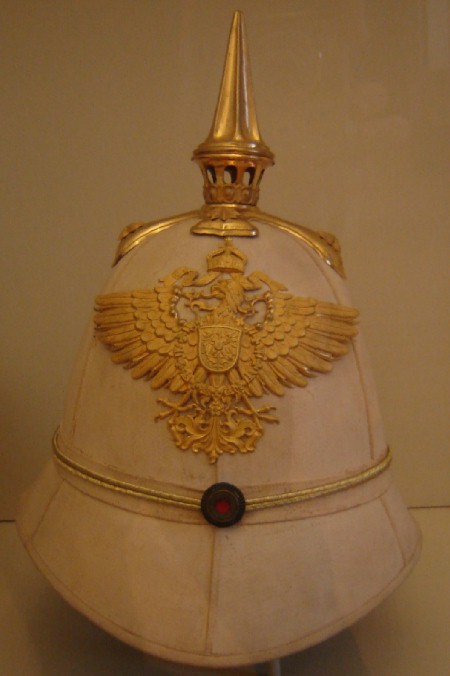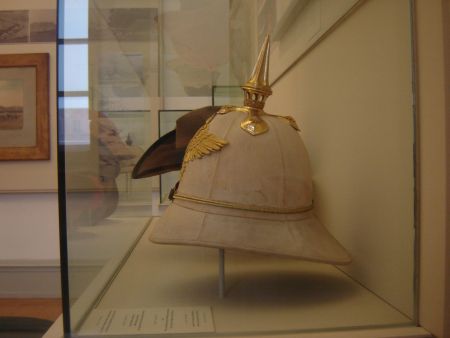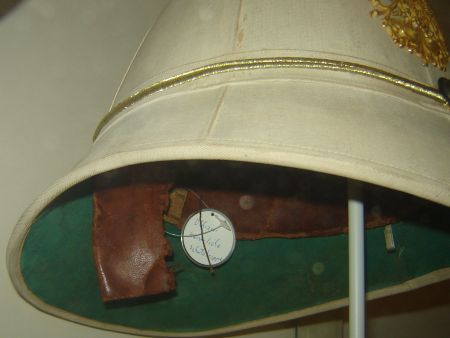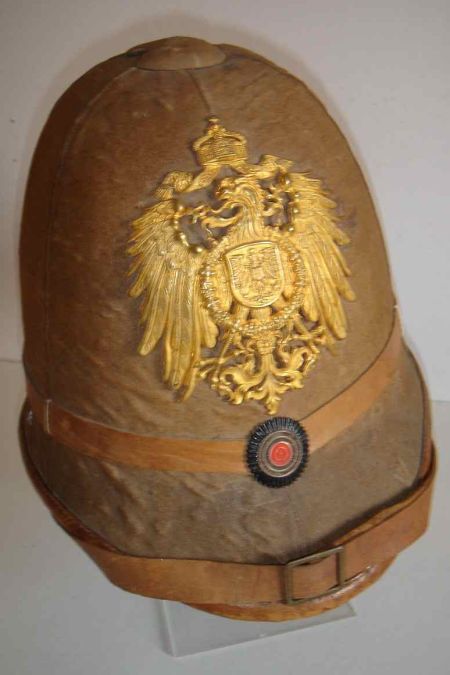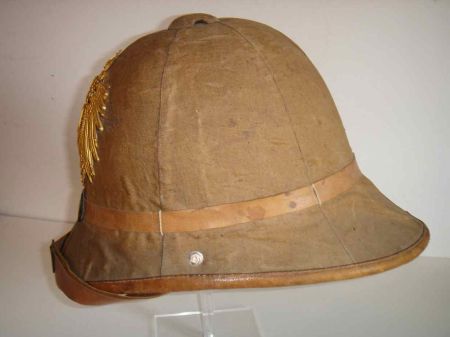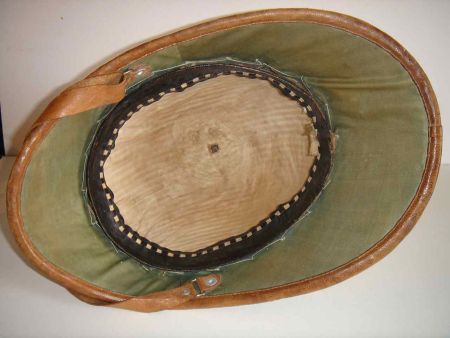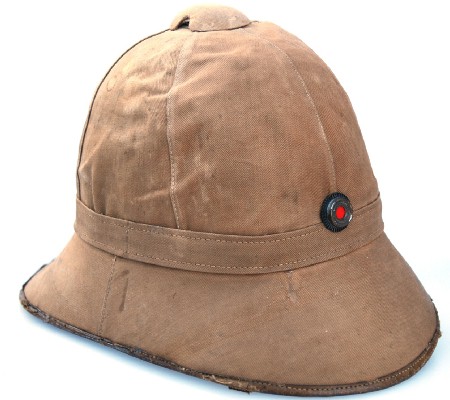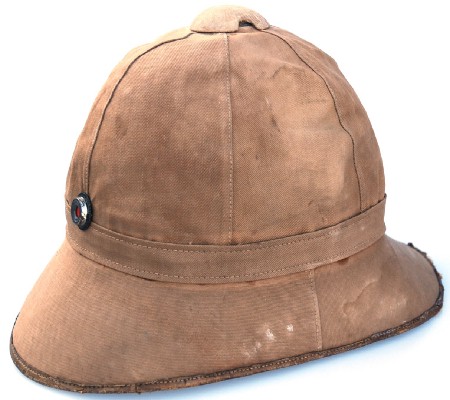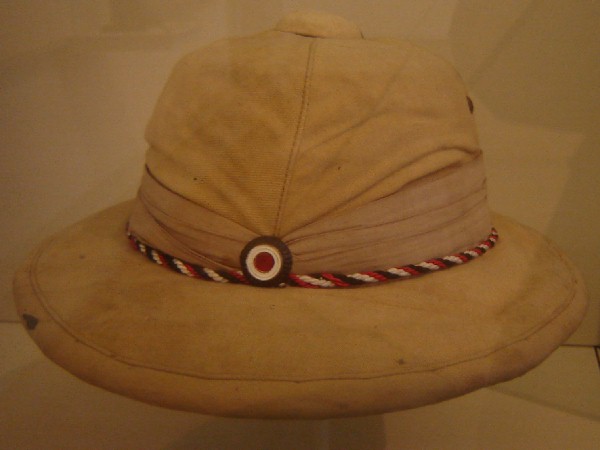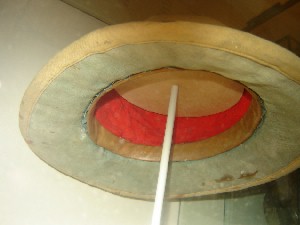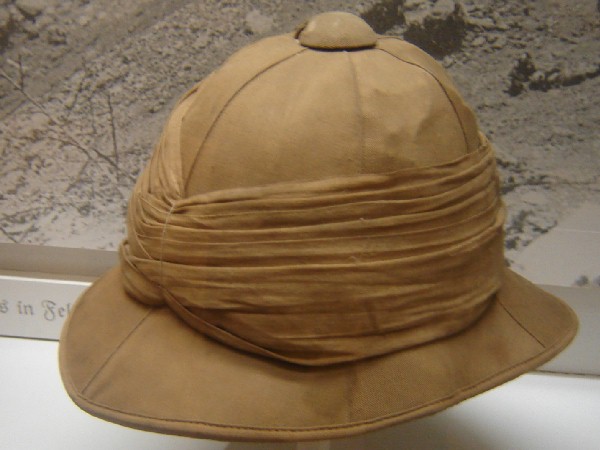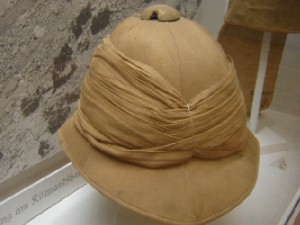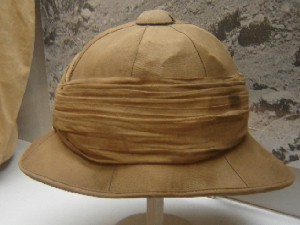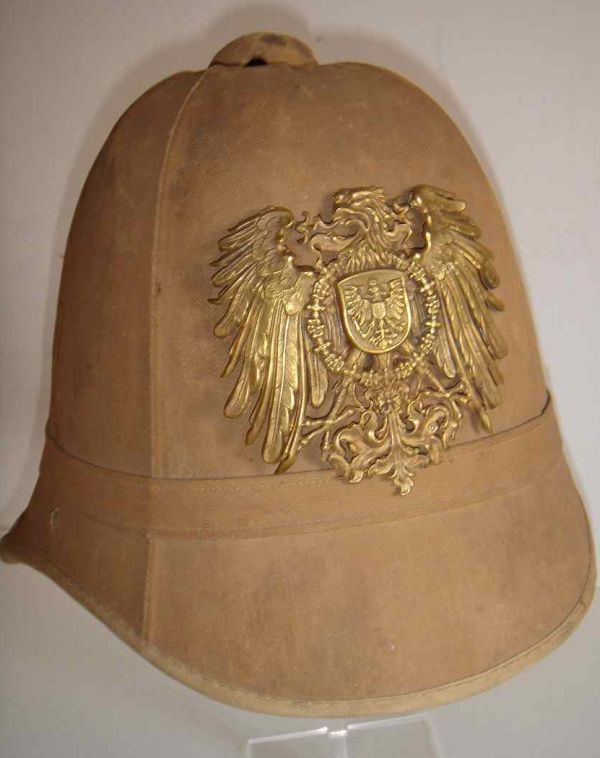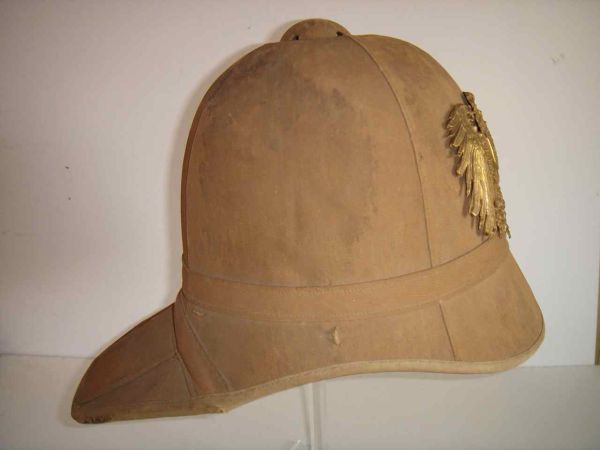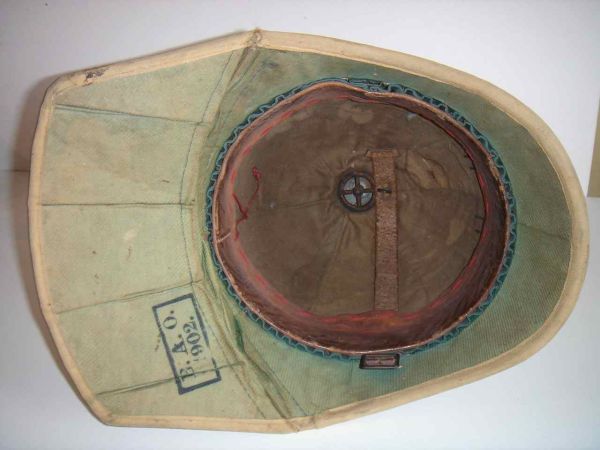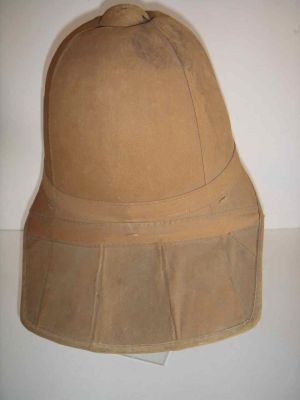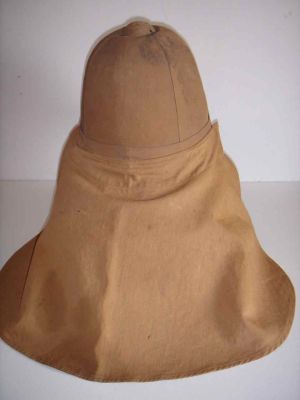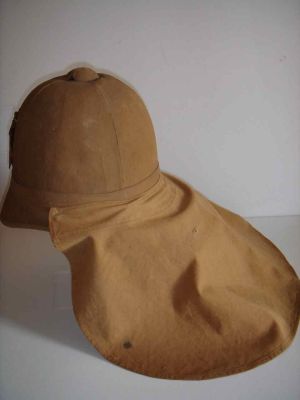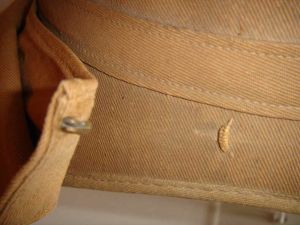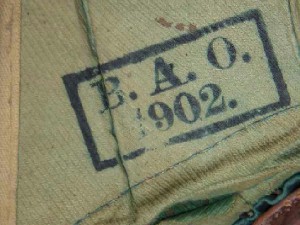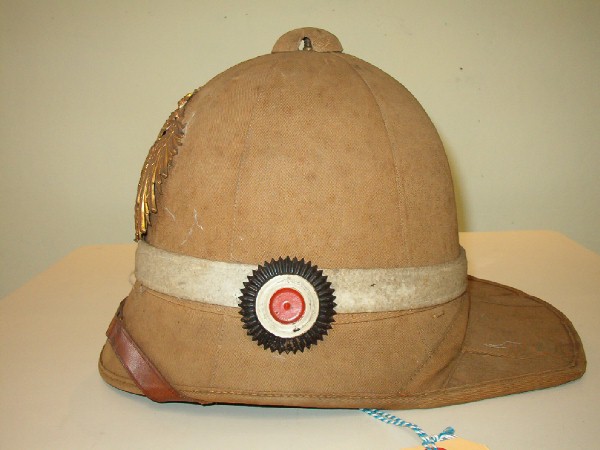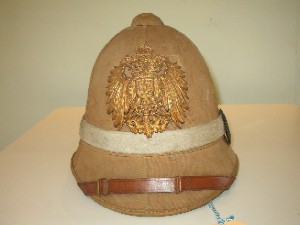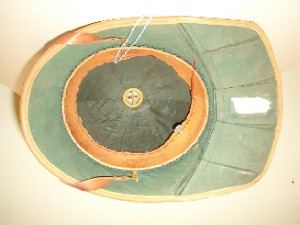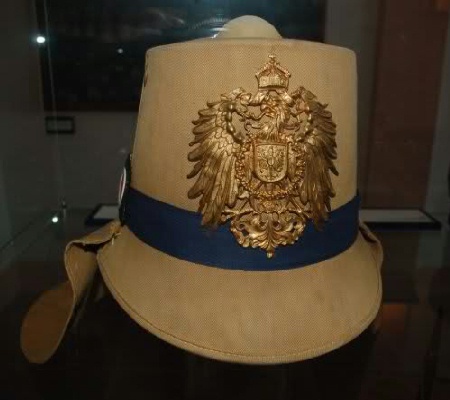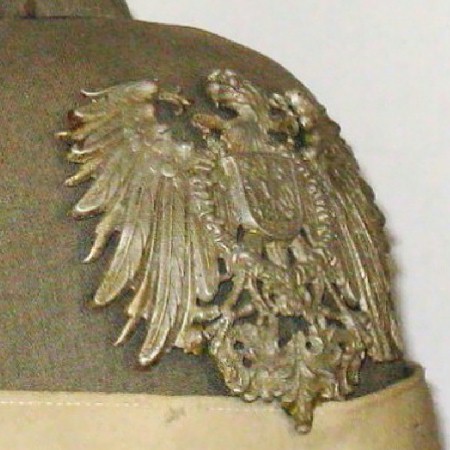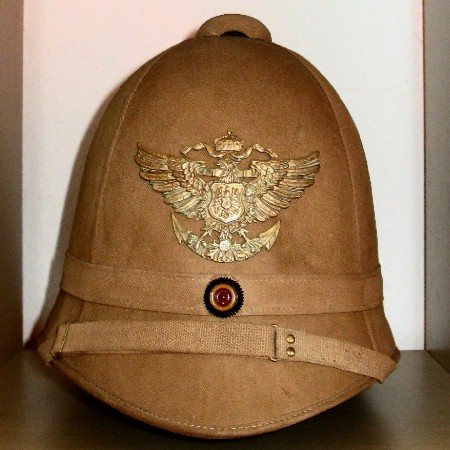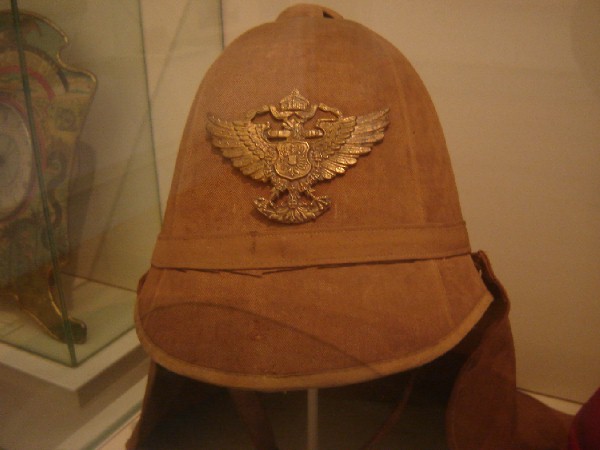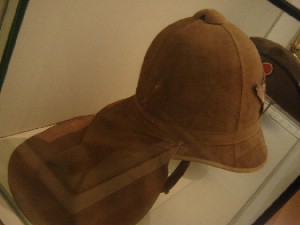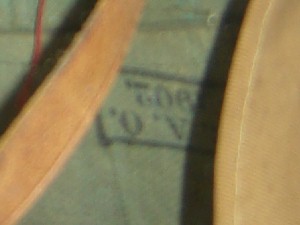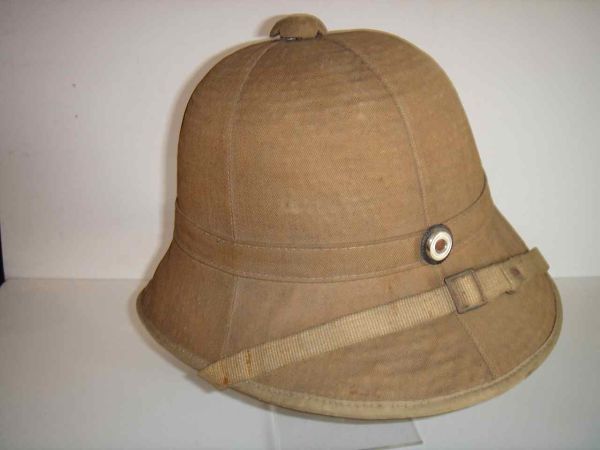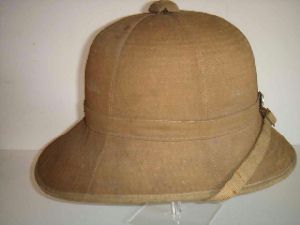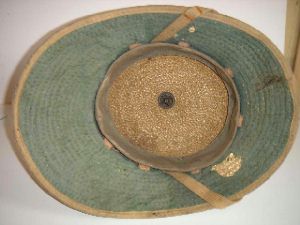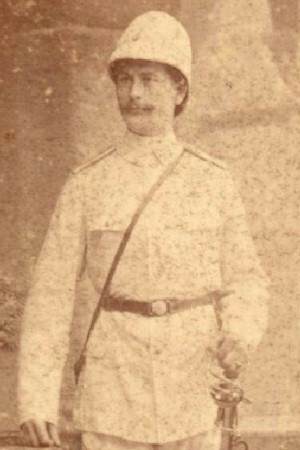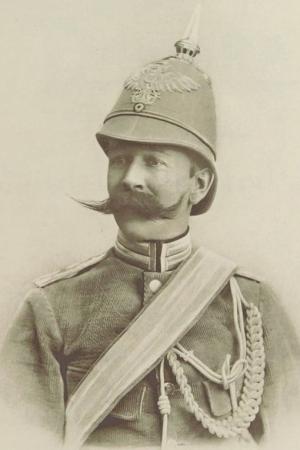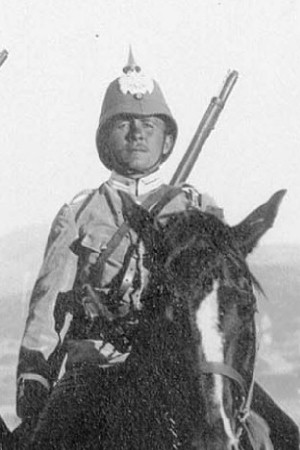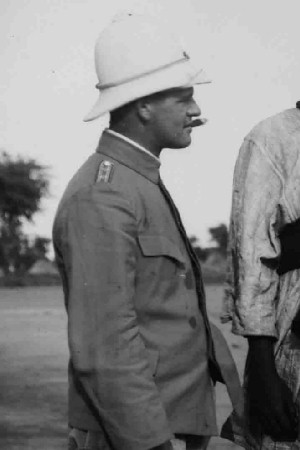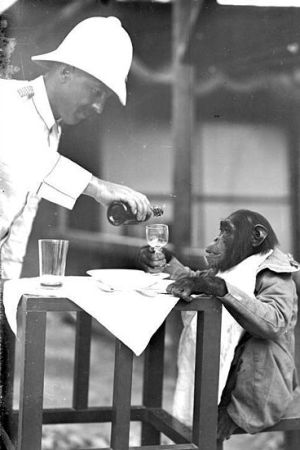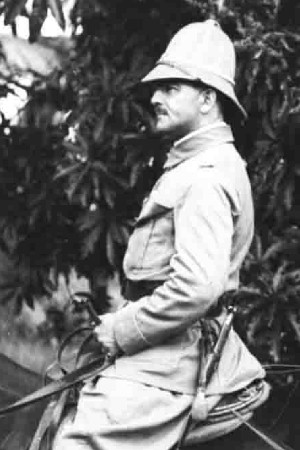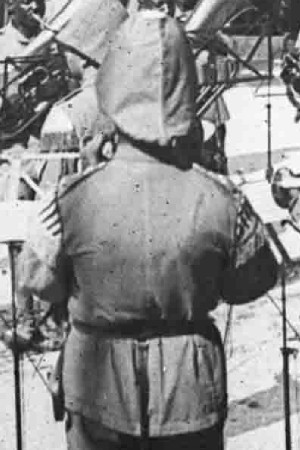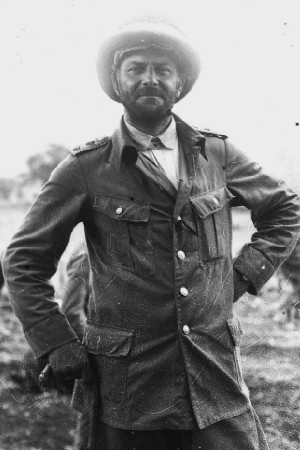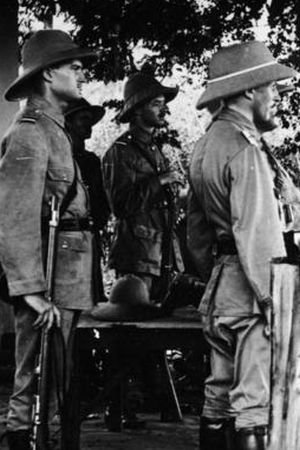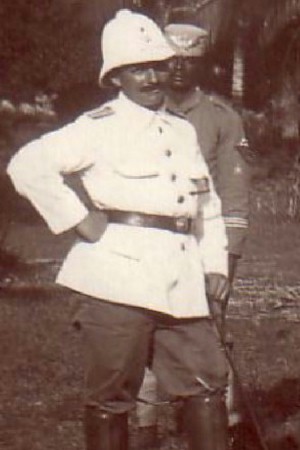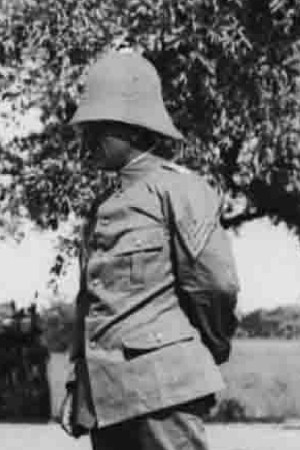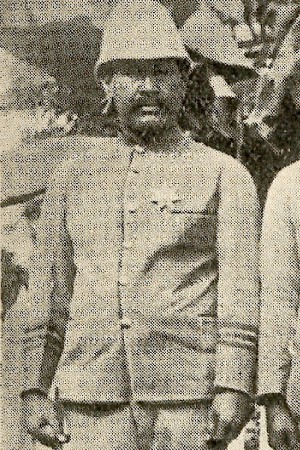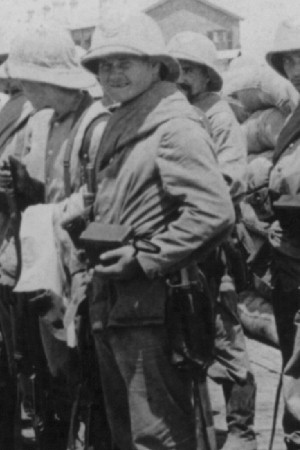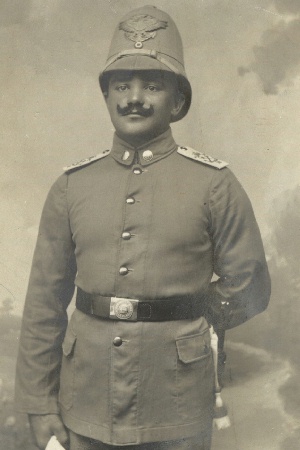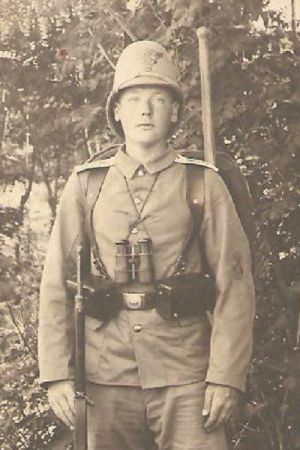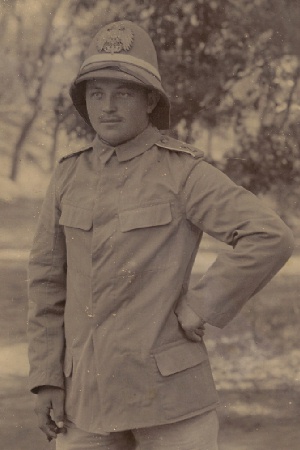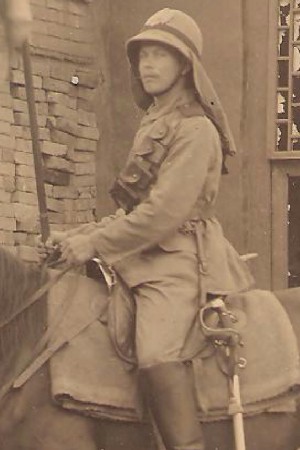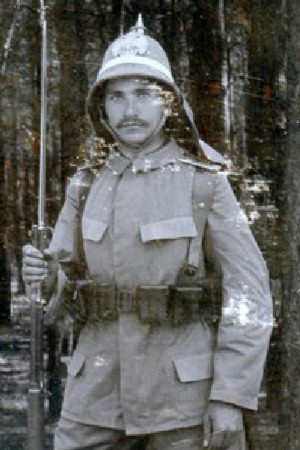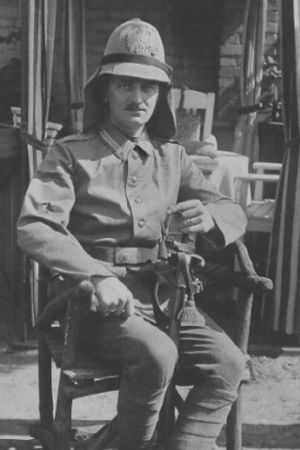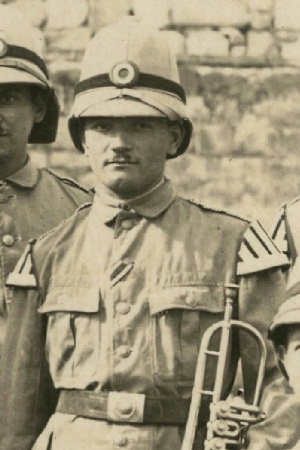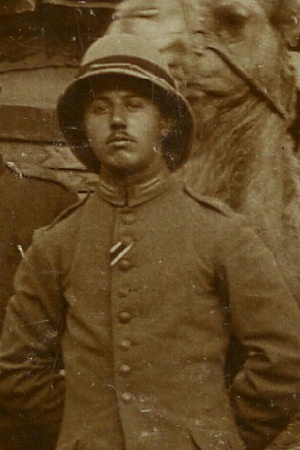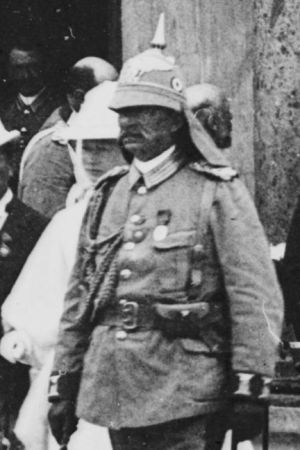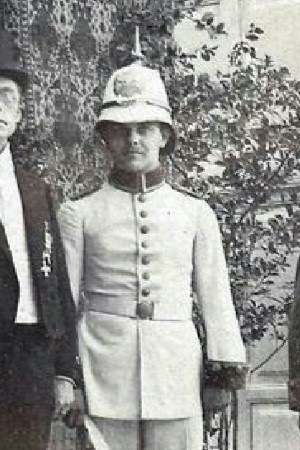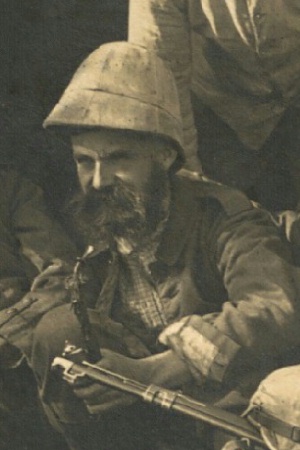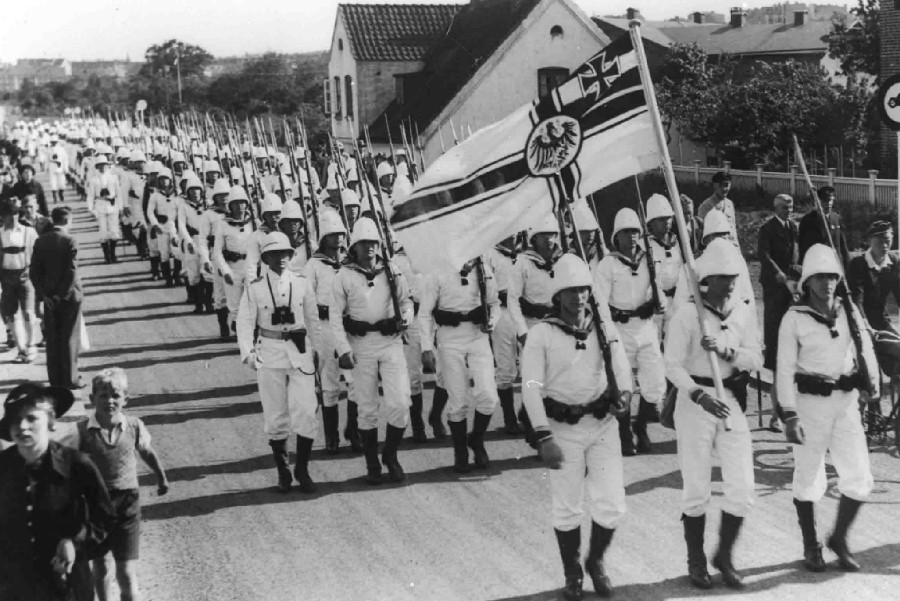|
Tropical helmets worn by
Imperial Germany's colonial and overseas troops were made of several different
materials, most commonly woven reeds, cork, wood pulp or pith and sometimes
wholly or partially of rubber. The basic helmet was then covered in
cloth, usually white or khaki but sometimes other colours were painted
white. Ventilation
pommels were often removable and
could be replaced with a Pickelhaube-style spike by some units. Khaki
covers were sometimes worn over white helmets when on campaign, and
conversely white covers were sometimes worn over khaki helmets. These
covers often had a hole at the top and were held in place by
unscrewing the ventilation
pommel and replacing it over the
cover.
Because
of the circular nature of the weave in reed helmets they were usually
quite low in
height with a rounded brim. Cork helmets were often higher, with
individually shaped front and rear peaks. Rubber
rubber peaks were sometimes made to go with cork helmets. The practice
of dyeing white uniforms into a light brown shade with tea, coffee or
local plant extracts on campaign could not be applied so successfully
to tropical helmets as the cork disintegrated in boiling water.
German tropical
helmets issued to the overseas forces were made by several different
companies (such as
A Emter in
Berlin,
H Pfeiffer in Hamburg, Lehmann and
Wundenberg in Hanover
and most famously,
Ludwig Bortfeldt in Bremen). Helmets were also purchased from Britain, France
and the United States. Furthermore, officers and senior NCOs often had their
helmets privately made by other companies. These different
manufacturers often made helmets to slightly different specifications of size and
shape thus some period photographs show wide ranges of shaped helmets
even within one unit grouping.
East African
Schutztruppe
German Officers and NCOs of the Wissmanntruppe,
formed in 1889, wore tall
English style cork sun helmets,
covered in white cloth. Some though judging
from period photographs, not all had an Imperial cockade at the front,
some are seen with a pugaree around the helmet. Khaki
covers could be worn on active service.
New regulations for
the Schutztruppe formed in 1891, kept the
same tall white
helmets with khaki covers and confirmed the use of an imperial cockade
at the front. An imperial eagle with spread wings in yellow metal was
worn on the front of the helmet above the cockade and a yellow metal
spike with a cruciform base was added. Medical officers and officials
helmet eagles had folded wings with some being of white metal (with
matching spikes) depending on arm of service. Officers wore a yellow
metallic cord around the hatband. On garrison duty the cord and eagle
were not worn and the spike was replaced by a simple ventilation
pommel. On field duty a khaki cover was worn with the cockade on the
outside. It also seems from period photographs and surviving examples
that khaki helmets were worn during this period although not
authorised.
On 19th November 1896
new regulations kept the same basic form of the white helmet and also
permitted khaki helmets. The eagle and spike were now dispensed with
and the officers cord was changed to a white metallic one. On 29th
December 1913 further regulations brought in a new helmet, lower in
height and only authorised in khaki (although a white cover could be
worn on parade). NCOs were now permitted to wear a black/white/red
twisted cord around the hatband.
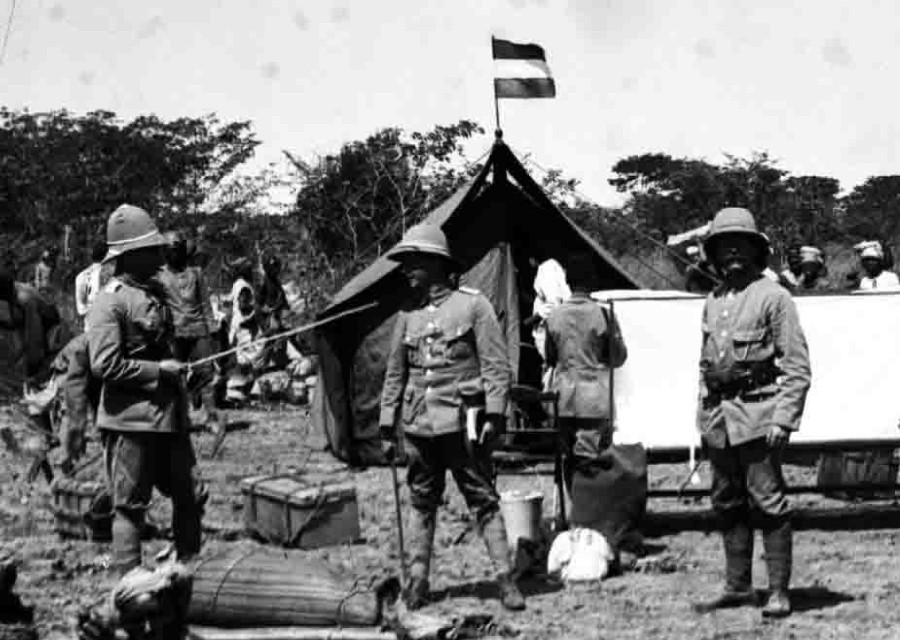
Schutztruppe Officers in
German East Africa c1914
The difference in shape between the tall 1891/96 Helmet worn
on the left and the lower more rounded 1913 Helmet in the centre and
right is clear in this photograph.
Photo ©
Frankfurt University Koloniales Bildarchiv
Photographs of the
Schutztruppe during the First World War show them wearing both the
1896 and 1913 helmets side by side. In addition many privately owned
tropical helmets from various sources were worn by new recruits in the
Schützenkompagnien. Some of the Schützenkompagnie soldiers are seen in
contemporary photographs with a small metal imperial eagle on the
front, possibly the same as worn by Askaris on their tarbush. Captured British
Wolseley helmets were also popular with the
Schutztruppe.
South
West African Schutztruppe
Tropical
helmets were introduced for the South
West African Schutztruppe in 1892. They were tall
cork helmets covered in khaki cloth, with white metal
imperial eagles (with spread wings
for officers and
folded for other ranks), imperial
cockades and a white metal spike with cruciform
base. These helmets were discarded in the mid
1890s. The Schutztruppe of South West Africa did not wear sun
helmets thereafter.
Cameroon Schutztruppe
The Cameroon Schutztruppe followed the same regulations as
those in East Africa (described above). Photographs show many
variations of shape of helmet were worn,
made by different manufacturers. Again reservists during the
First World War are seen in contemporary photographs with a small
metal imperial eagle on the front, possibly the same as worn by
African troops on their fez.
Polizeitruppe
Polizeitruppe German officers and NCOs
in East Africa, Cameroon, Togo, New Guinea and Samoa wore tall
white tropical helmets with imperial cockades on the front.
From 1906 a
small yellow metal
imperial eagle was added
above the imperial cockade and from 1912 senior police NCOs ("Wachtmeister")
were authorised to wear a black/white/red twisted cord around the
hatband.
Again many variations in shape,
style and manufacturer can been seen in period photographs.
Khaki covers may have been worn on active service.
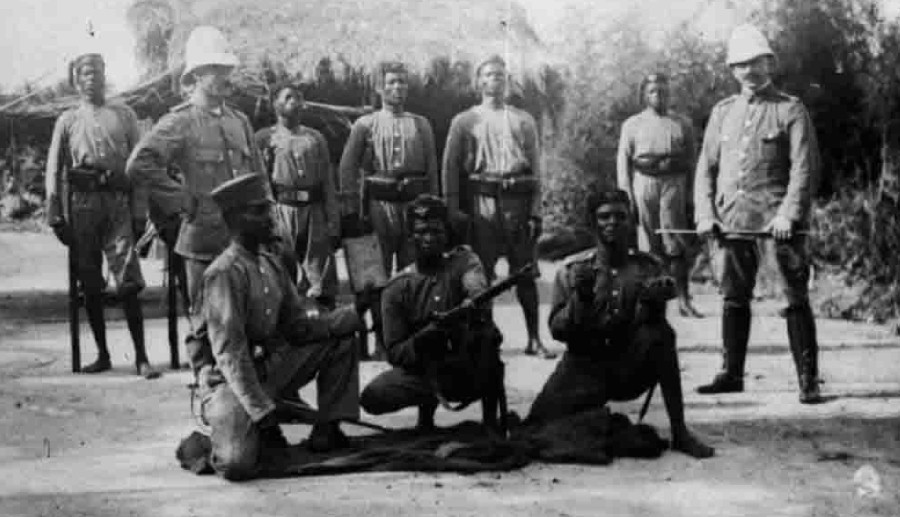
Togo Polizeitruppe c1914
The two German NCOs wear white 1891 Tropical Helmets
Photo ©
Frankfurt University Koloniales Bildarchiv
South West African Landespolizei
The
Landespolizei in South West Africa were issued
tropical helmets only in two areas,
the Caprivi Strip and the diamond mining are South of Lüderitzbucht.
Their helmets were white, with a small imperial cockade
on the front and a brass imperial
crown above it.
Army
Officers Seconded to the Colonies
Regular Imperial Army officers were occasionally seconded to the
colonies. They wore Schutztruppe uniform but with army insignia. Their
tropical helmets had both the imperial
cockade and their own army unit’s state cockade
below it.
Colonial
Officials
Except in South West Africa, the
doctors, paymasters, gunsmiths and other officials that accompanied the Schutztruppe wore
white and khaki Schutztruppe helmets.
On the front was an imperial cockade. Above the
cockade some officials wore insignia in the form of a brass or white
metal imperial eagle or shield with different insignia depending on
their special trade.
Photographs of surviving officials helmets sometimes show them worn
with a hatband
on their tropical helmets in
the same colours as the hatband on their field caps.
Most German civilian officials
in the colonies were entitled to wear uniform. From
governors to postmen, many wore tropical helmets with
variations on the imperial eagle and cockades.
East Asian
Expeditionary Corps and Occupation Brigade
In December 1900 the East
Asian straw hat was officially replaced with a tropical helmet made by
Ludwig Bortfeldt of Bremen and patented in September 1900. It was a
khaki covered cork helmet with rubber front and rear peaks. It
had an imperial eagle
with folded wings (usually in brass, though
pioneers and staff officers wore white metal)
and a hatband in arm of service colours (infantry- white,
cavalry - red, artillery and
pioneers - black edged in
red). Pinned onto the right side of the
hatband was a large imperial cockade. The helmet came with a
removable khaki
neckshade. One period photograph shows that the ventilation
top could be removed and replaced with a spike on parade. A curious
feature of Bortfeldt helmets is their
rear peak, which could be folded upwards and out of the way
when the wearer was firing from a prone position.
One interesting version
of the East Asian tropical helmet was the tropical shako.
It was made to the same rough shape as the Jäger shako, but made of
khaki covered cork and with the
same brim as the East Asian tropical helmet. It also had the
same eagle, cockade and removable neckshade as the
tropical helmet. It
was worn by the East Asian Jäger (with a green hatband,
until
they were disbanded in 1901) and East Asian train troops (with
a
blue hatband).
In 1904 the khaki
summer uniform was replaced with a lightweight field grey summer
uniform. The khaki helmet was also replaced with a new field grey
Bortfeldt helmet. This new
helmet was similar in style, with imperial eagle, hatband, cockade and
folding rear peak
but it was slightly smaller. This helmet continued in use until the
disbandment of the East Asian force in 1909.
The mass production
of 15,000 Bortfeldt 1900 Khaki Helmets and their subsequent
replacement in 1904 along with the gradual disbandment of the East
Asian Occupation Brigade meant that Germany had a large surplus of
these helmets kept in storage which would later appear on the Middle
Eastern and Balkan fronts during the First World War.
Imperial Navy
In 1885 officers of
the imperial navy were authorised to wear tropical helmets
in hot climates. They were made from woven reeds covered in white
cloth and had a yellow metallic double cord around the hatband
(or a single cord for junior officers). Period photographs show
imperial cockades were usually worn on the front. In 1891 tropical
helmets were also authorised
for other ranks, again made from woven reeds but covered in khaki cloth.
Several variations and improvements were made on these helmets until
they were replaced by the
Bortfeldt 1900
helmet as used by the East Asian troops (described above). The new Bortfeldt
helmets were still issued with imperial cockades at the front and in
white for officers with yellow metallic cords and khaki for other
ranks. A few photographs show black
cap tallies with the name of the wearer's ship worn around the hatband
of the tropical helmet although this does not appear to have been
standard practice.
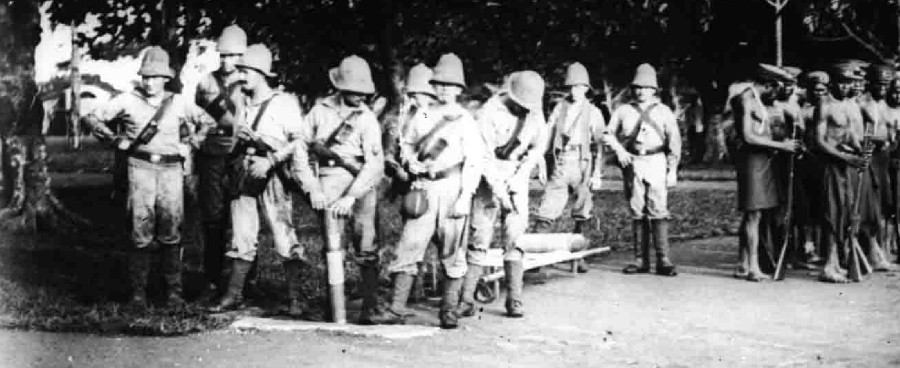
Naval Landing Party, Ponape 1910-11
They wear 1900 Bortfeldt
khaki Tropical Helmets, note
the figure fourth from left has the rear peak folded up.
Photo ©
Frankfurt University Koloniales Bildarchiv
Marine Infantry - Seebataillone
In 1898 the III.
Seebataillon in Tsingtao were issued white tropical helmets. They had a white metal imperial eagle superimposed over an anchor in
the style worn on the Seebataillon shakos, over a small imperial
cockade. Several changes to the design of the
helmet occurred over the following years. On 28th June 1900 the
eagle was authorised in bronze rather than white metal, and in 1905
the helmet was officially changed to a khaki one for other ranks
with officers and senior NCOs still wearing white. These uniform
orders do not however tell the full story and are often contradicted
by photographic evidence.
For example, khaki helmets have been
seen in photographs of the Seebataillone as early as the Boxer
Rebellion of 1900. From such photographs it seems that the I.
Seebataillon had khaki helmets, while the II. Seebataillon had white
helmets (sometimes worn with khaki covers). The III. Seebataillon
also received khaki helmets around this time, either shortly before
or after the Boxer Rebellion. During this
period, as mentioned above photographs of officers and senior NCOs
of all battalions seem to be mostly wearing white helmets.
Furthermore photographs clearly show that the Marine
Expeditionskorps in South West Africa wore khaki helmets in 1904, so
the regulation order of 1905 for khaki helmets seems to have been
largely retrospective. Later photographs of III. Seebataillon
officers and senior NCOs in China sometimes show them wearing
khaki tropical helmets. Officers were also authorised to wear a
gold coloured cord around the hatband of the helmet.
Early issues of the helmet were quite low in
height with a rounded brim. Later helmets were taller with a more steeply
inclined brim and removable neckshades. The 1900 Bortfeldt tropical helmet with
its folding rear peak was issued to Seesoldaten in South West Africa
during 1904-05, and also to the III. Seebataillon in China from
about the same period. Throughout these changes, officers often wore
privately purchased versions which sometimes varied in shape.
Some photographs taken
on campaign in South West Africa and China show the helmets worn without
their metal eagles. Photographs of troops on manoeuvres in Tsingtao show
them sometimes wearing a red hatband around the tropical helmet. This
was to distinguish opposing sides during simulated battles.
German Army in
Palestine
and Macedonia
Stocks of the old East Asian 1900
Khaki
Bortfeldt helmets
with their folding rear peaks and removable neckshades
were
re-used during the
First
World
War
by the Pascha I and II ("Asienkorps") expeditions in Palestine and also by German troops in Macedonia.
They initially
retained the imperial eagle,
coloured
arm of service hatband and pinned cockade
from their previous service. Later photographs show some or all of
this insignia removed. Some photographs of the Pascha I show
them wearing their cockades on the front rather than the right side,
and at least one photograph shows them worn on the left side. The Asienkorps stopped wearing
tropical helmets
in action soon after their deployment as they looked too similar to
the British sun helmets, and caused friendly fire incidents.
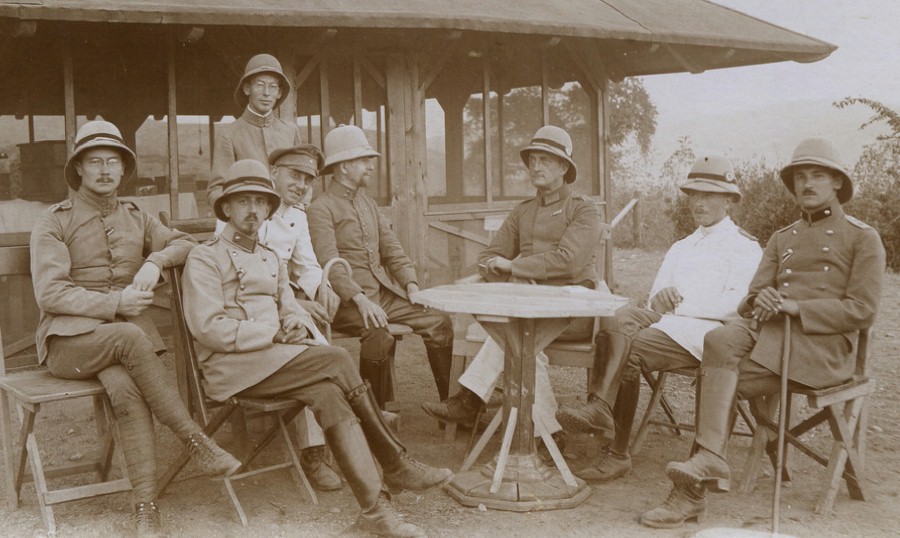
German Army Doctors, Macedonia
c1917
They mostly wear what appear to be 1913 Schutztruppe Tropical
Helmets, with their low wide form, though some officers have helmets
from other, possibly private sources. Most have arm of service
hatbands (most likely in dark blue with red edging for the medical
service) and large imperial cockades on the left or right sides.
Photo © Joe Robinson
Privately
Purchased Tropical Helmets
Officers and some NCOs in the German armed forces purchased
their own uniforms and equipment, often from private tailors and
outfitters. Although their tropical helmets were required to abide
by regulations they often had many variations in shape and style.
Unofficial
Tropical Helmets
All manner of locally produced and imported tropical helmets were in
circulation in the German colonies worn by settlers, tradesmen and
doctors. These often found their way into military use when these
same men were called up as reservists in the First World War.
Captured
Tropical Helmets
Particularly in German East Africa during the First World War, the
Schutztruppe resorted to wearing captured enemy tropical helmets as
their own became worn out. Particularly popular were the British
Wolseley Helmets.
Austro-Hungarian
Tropical Helmets
Austria-Hungarian army units in Create 1897-98 and Palestine
1916-18 wore tropical helmets made by
P&C Habig
in Vienna.
See-
Austro-Hungarian Tropical
Helmets Post War
Constructions and Forgeries
The myriad of different types of tropical helmet, both issue and
privately purchased make it almost impossible to tell if a helmet in
a modern collection is a one of a kind rarity or a modern fake.
Props from theatre productions and films have also made their way
into onto the market from time to time further confusing collectors
and historians. Be aware of fakes!
Highly Recommended
Reading-
"Tropenhelme der kaiserliche Marine, der
Ostasiatischen Truppen und der Schutzruppen" by Ulrich Schiers
(published by the
Deutsche Gesellschaft für Heereskunde available to order
here)
"Military Sun Helmets of the World" By Peter Suciu
with Stuart Bates (see
Military Sun
Helmets for more information). |
|
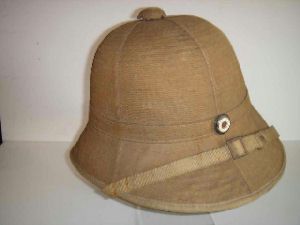
1891 Naval Other Ranks
Helmet
This is a helmet constructed with woven reeds covered in
khaki cloth, note the low round shape.
(See
Below for Close up
Photographs)
Photo © Doppler Collection
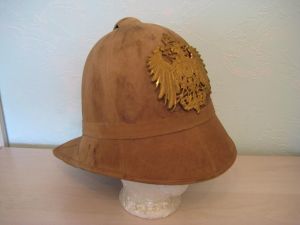
1900 East Asian
Bortfeldt Helmet
Made of pith with rubber peaks (folding at the rear),
note the higher shape and less rounded appearance. Also note
the East Asian imperial eagle with folded wings.
Photo © Private Collector
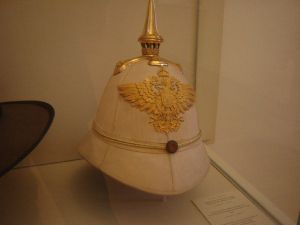
1891 Schutztruppe
Officers Helmet
Note the Schutztruppe imperial eagle with spread wings
and spike only worn on parade.
(See
Below for
Close up Photographs)
Photo ©
C Dale taken at the Rastatt Military Museum
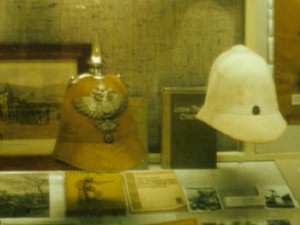
Early Schutztruppe Helmets from Africa
On the left is an example
of the short lived 1892 South West African Schutztruppe khaki tropical
helmet with a white metal spike and eagle (with spread wings for
officers) and an imperial cockade.
On the right is an 1891 East African (or
Cameroon) Schutztruppe tropical helmet as worn on garrison duty
without the eagle or spike bur retaining the imperial cockade.
Photo ©
Traditionsverband from the Siebentritt
Collection
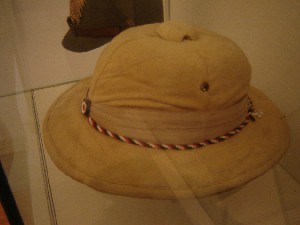
Schutztruppe Tropical
Helmet c1913
This helmet bears the wide rounded shape of the 1913
Schutztruppe helmet and has the imperial coloured cord of an
NCO.
Photo ©
C Dale taken at the Rastatt Museum
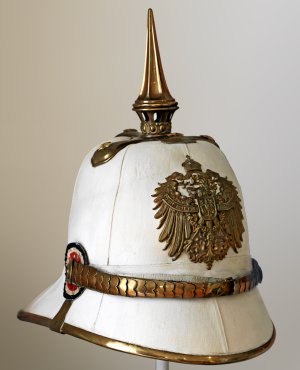
Diplomatic Service Helmet
This helmet with
brass imperial eagle, a fluted spike and chinscales belonged
to Wilhelm Wassmuss in Persia.
Photo from
Braunschweigisches Landesmuseum /
Wikimedia
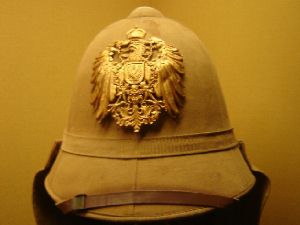
1900 East Asian
Bortfeldt Helmet
Photo
© C Dale from the
Imperial War Museum Collection
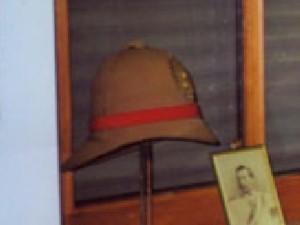
1900 Bortfeldt East Asian Helmet
This helmet still has its
imperial eagle and arm-of-service coloured hatband (in this case red
for the cavalry) but not its imperial cockade usually seen on the
right hand side.
Photo ©
Traditionsverband from the Siebentritt
Collection
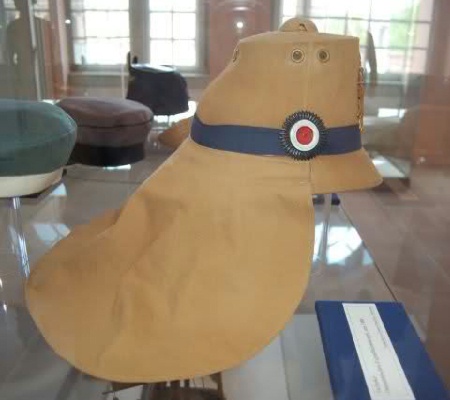
1900 Bortfeldt Tropical Shako
for the East
Asian Train Company
Photo by Kilimandscharo of
the
Kolonial Geschichte Forum
taken at the Rastatt Military Museum
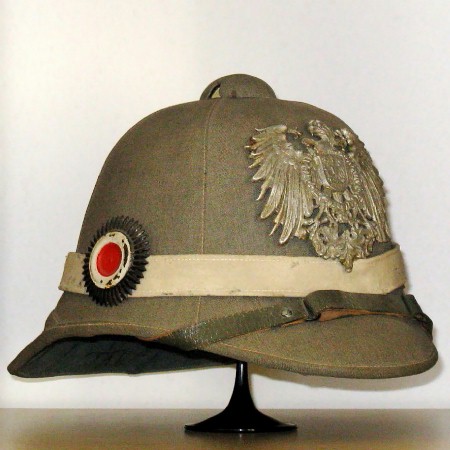
1904 Bortfeldt
Helmet
for the East Asian Infantry
Photos ©
Private Collector
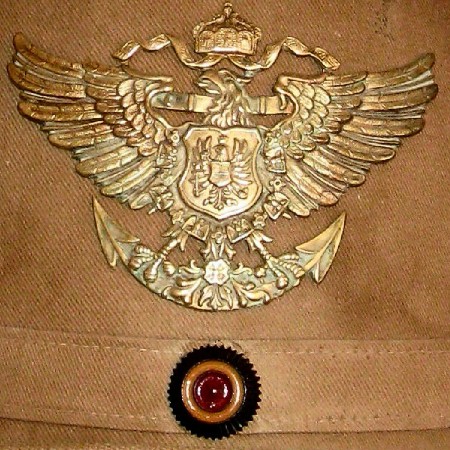
III Seebataillon Eagle with Anchor
On the front of a Bortfeldt
1900 Helmet
Photo ©
Private Collector
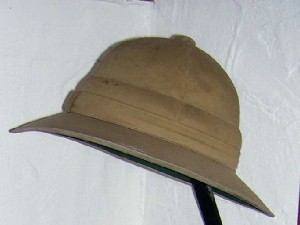
Privately Purchased Helmet
This is a privately
purchased tropical helmet worn by a doctor in South West
Africa. It is not regulation issue and has no cockade or
insignia, but is yet another example of the variety of
styles of tropical helmets worn in the German colonies.
Photo © Arne Schöfert from the
Kolonialmuseum Linke
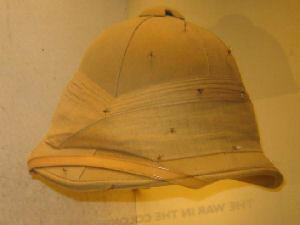
British Wolseley Helmet
The British Wolseley
tropical helmet was commonly worn by British troops in Africa, India,
China and the West Indies. It was also popular with the German Schutztruppe in
East Africa when captured during the First World War.
Photo
© C Dale from the
Imperial War Museum Collection
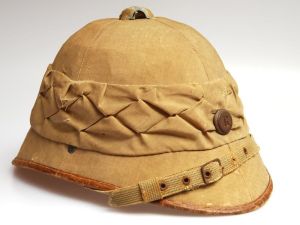
Austro-Hungarian Tropical
Helmet
This is of the type
latterly issued to the Austro-Hungarian Army in Palestine
with a badge at the front bearing the "K" monogram for
Kaiser Karl.
Photo © Peter Suciu - see
Austro-Hungarian Tropical
Helmets

Curious Tropical Helmet
Note the post horn
below the white metal Imperial eagle, dark hatband, grey
green colour and tall shape. This helmet does not conform
directly to any known regulations. It has been suggested
that the helmet is from a colonial postal service or that it
is a miscoloured helmet from the East Asian cavalry. It may
also be a later made composite of parts of different
helmets.
Photo © Private
Collector |



















